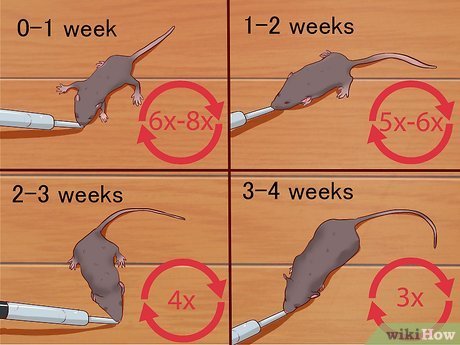

Essential Guide: How To Care For Baby Mice
Taking care of baby mice is a delicate task that requires attention and compassion. To ensure their well-being, it’s crucial to provide them with the right environment and nourishment. Baby mice need warmth, gentle handling, and a proper diet to thrive. By understanding how to take care of baby mice, you can help these tiny creatures grow into healthy adults. Join us as we explore the essential steps to nurture these adorable little beings.
How to Take Care of Baby Mice
Introduction
So, you’ve found yourself taking care of some cute baby mice, and you want to make sure they grow up healthy and happy. Baby mice, also known as pinkies or pups, require special care and attention to thrive. In this comprehensive guide, we will walk you through everything you need to know about taking care of these tiny, delicate creatures.
Setting Up Their Home
Before bringing baby mice into your home, it’s important to set up a warm and safe environment for them. A small plastic or glass aquarium with a secure lid works best as a temporary home for baby mice. Line the bottom of the tank with soft, clean bedding such as paper towels or shredded paper to keep them cozy.
Temperature Control
Baby mice are sensitive to temperature, so it’s crucial to keep their environment warm. Maintain a temperature of around 75-80°F (24-27°C) in their enclosure to ensure they stay comfortable and healthy. You can use a heat lamp or a heating pad placed under one side of the tank to create a warm spot for them to snuggle up to.
Lighting and Noise
Mice are nocturnal creatures, so it’s best to keep their living area in a quiet and dimly lit room during the day to allow them to rest. Avoid sudden loud noises or bright lights that can startle or stress out the baby mice.
Feeding Schedule
Proper nutrition is essential for the growth and development of baby mice. If you are taking care of orphaned or abandoned pups, you may need to hand-feed them using a small syringe or dropper. A specialized formula for rodent babies can be obtained from a pet store or veterinarian.
Frequency of Feeding
Baby mice need to be fed every 2-3 hours, including during the night, as they have tiny stomachs that empty quickly. Make sure the formula is at room temperature before feeding and only offer small amounts at a time to prevent overfeeding, which can lead to health issues.
Transitioning to Solid Food
As the baby mice grow, you can start introducing solid food into their diet. Soft foods like oats, fruits, and vegetables can be offered to them once they are about two weeks old. Make sure to provide fresh water in a shallow dish for them to drink from.
Handling and Socialization
It’s important to handle baby mice gently and with care to prevent injuries and stress. Slowly introduce handling by picking them up for short periods a few times a day to help them get used to human interaction. This will help them become more social and comfortable around people as they grow older.
Creating Bonding Time
Spending time with baby mice is crucial for their social development. Sit near their cage and talk to them softly to get them used to your voice. Offering them small treats like sunflower seeds or mealworms can also help build trust and create a positive association with humans.
Playtime and Enrichment
Baby mice are curious and active creatures, so providing them with toys and items to explore can help keep them engaged and stimulated. Simple items like toilet paper rolls, cardboard tubes, and small climbing structures can offer entertainment and enrichment for the baby mice.
Health and Wellness
Monitoring the health and wellness of baby mice is essential to ensure they are thriving and free from illness. Keep an eye out for any signs of distress, such as lethargy, loss of appetite, or difficulty breathing, and consult a veterinarian if you notice any concerning symptoms.
Cleaning and Hygiene
Maintaining a clean environment is crucial for the health of baby mice. Regularly clean their enclosure by removing any uneaten food, soiled bedding, and droppings to prevent the buildup of bacteria and odors. Replace the bedding at least once a week and sanitize the tank with a mild detergent.
Veterinary Care
If you notice any unusual behavior or symptoms in the baby mice, it’s important to seek veterinary care promptly. A veterinarian experienced in treating small animals like mice can provide proper diagnosis and treatment for any health issues that may arise.
Taking care of baby mice requires patience, attention to detail, and a lot of love. By providing them with a warm, safe environment, nutritious food, gentle handling, and regular health check-ups, you can ensure that these tiny creatures grow up healthy and happy. Remember, each baby mouse is unique, so observing their behavior and adapting your care routine accordingly is key to their well-being. Enjoy the journey of watching these adorable creatures grow and thrive under your care!
How to Care for Baby Mice
Frequently Asked Questions
What should I feed baby mice?
Baby mice, also known as pinkie mice, should be fed a special formula designed for neonatal rodents. This formula can be purchased at pet stores or online. It’s important to feed them every few hours, as they have high energy needs for growth and development.
How often should I clean the baby mice’s cage?
It is essential to keep the baby mice’s cage clean to prevent health issues. Clean the cage at least once a day, removing any soiled bedding and food remnants. Make sure to replace the bedding with fresh material to keep the environment hygienic.
How do I provide warmth for baby mice?
Baby mice are unable to regulate their body temperature, so they require a warm environment. Use a heating pad or a heat lamp placed at one end of their enclosure to create a gentle warmth for them. It’s crucial to monitor the temperature regularly to ensure it stays within a safe range.
Final Thoughts
Taking care of baby mice involves providing warmth, proper nutrition, and gentle handling. Keep them in a cozy environment with clean bedding and ensure they are fed a diet suitable for their age. It’s important to monitor their growth and development closely to ensure they are healthy and thriving. By following these guidelines on how to take care of baby mice, you can help them grow into strong and healthy adults.

Determining How Many Years Is 4166 Days
4166 days equate to approximately 11.4 years. Converting days into years can often be a puzzling task, but worry not! Understanding the measurement of time in different units is key. Let’s delve into the conversion process of how many years is 4166 days. Time is a fascinating dimension we navigate daily, and knowing how to interpret it is both enlightening and practical. Join us on this journey of deciphering the relationship between days and years.
Understanding Time: Exploring How Many Years 4166 Days Equal
How Many Years is 4166 Days?
Have you ever wondered about the relationship between days and years? Let’s dive in and explore how many years exactly are in 4166 days.
Breaking Down the Numbers
To understand how many years are in 4166 days, we need to break it down into manageable parts. Let’s start by looking at how many days are in a year.
On average, a year consists of 365 days. However, every four years, we have a leap year with 366 days. This additional day helps keep our calendar aligned with the Earth’s revolutions around the sun.
Calculating Years from Days
Now, let’s do some math to find out how many years 4166 days equal. We can begin by dividing the total number of days by the average number of days in a year:
4166 days ÷ 365 days/year = 11.41 years
So, 4166 days are approximately equal to 11 years and 4 months. It’s fascinating to see how a simple calculation can convert days into years!
Real-World Applications
Understanding the relationship between days and years can have practical applications in various fields. For instance, in history, knowing how to convert days into years can help us accurately interpret timelines and historical events.
In science, converting days into years is crucial for calculating the age of celestial bodies or studying the growth of living organisms over extended periods.
Conclusion
In conclusion, we’ve discovered that 4166 days are equivalent to approximately 11 years and 4 months. This exercise highlights the interconnectedness of time and the importance of understanding how different units of time relate to each other.
Next time you come across a large number of days, try converting it into years using the simple formula we discussed. It’s a fun way to explore the concept of time and appreciate the significance of each passing moment.
Longest Video on YouTube 10,000,000 Hours but it’s 9 seconds
Frequently Asked Questions
How many years is 4166 days?
4166 days is equivalent to approximately 11 years and 5 months. To calculate this, you can divide the total number of days by 365 days (the average number of days in a year). This gives you the number of years, and the remaining days will give you the additional months.
Can you convert 4166 days into years?
Yes, 4166 days equals about 11 years and 5 months. By dividing the total number of days by 365 days (the average length of a year), you can determine the equivalent in years and months.
What is the equivalent number of years for 4166 days?
The total of 4166 days can be converted to approximately 11 years and 5 months. This calculation involves dividing the total days by the average number of days in a year (365) to get the years and months.
Final Thoughts
In conclusion, 4166 days is equivalent to approximately 11 years and 4 months. This time frame spans over a significant period, providing ample opportunity for growth and change. Understanding how many years 4166 days represents allows for better perspective on the passing of time and the importance of making the most out of each day. Time is a valuable resource, and it is essential to make the most of every moment.


